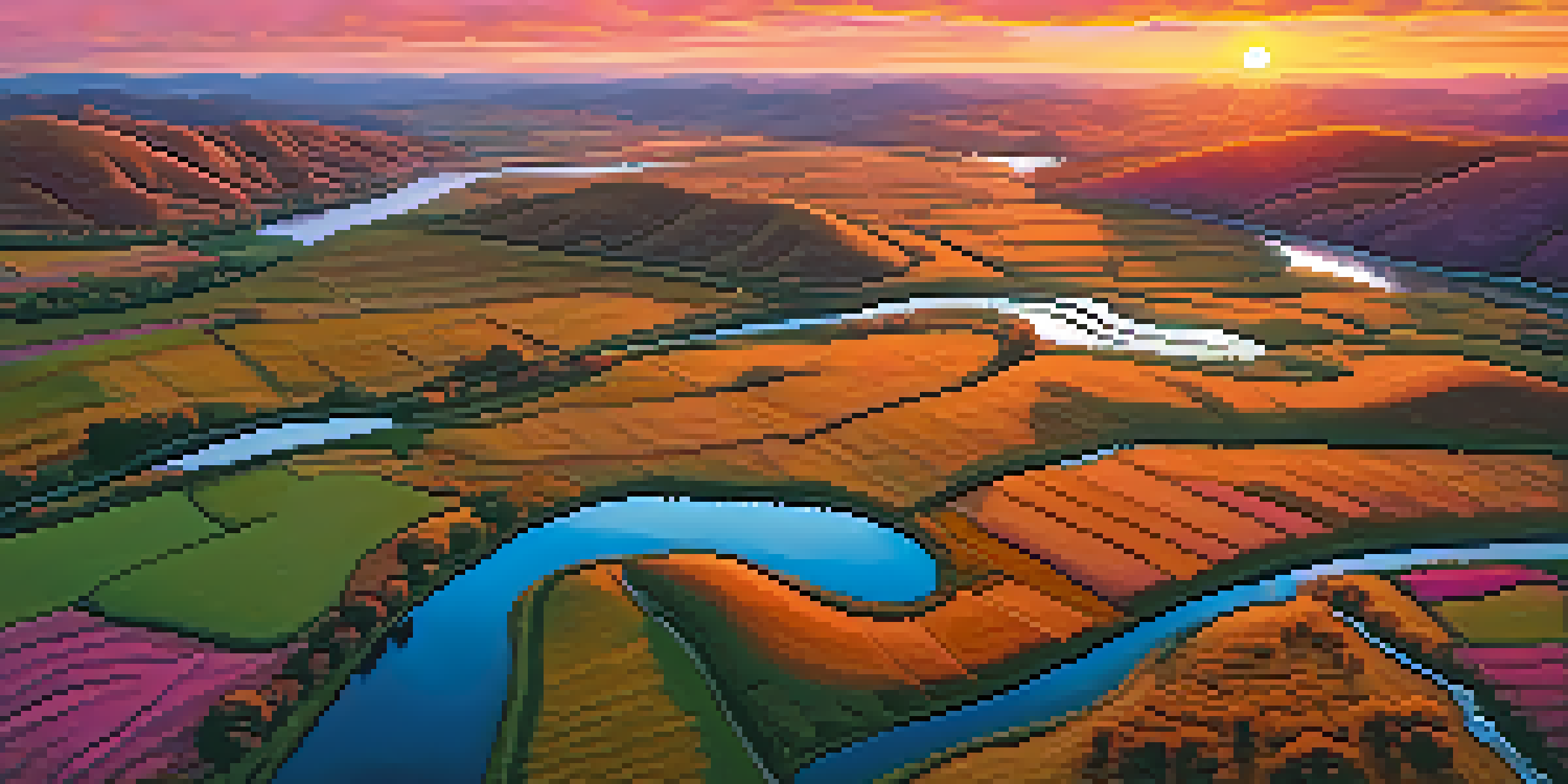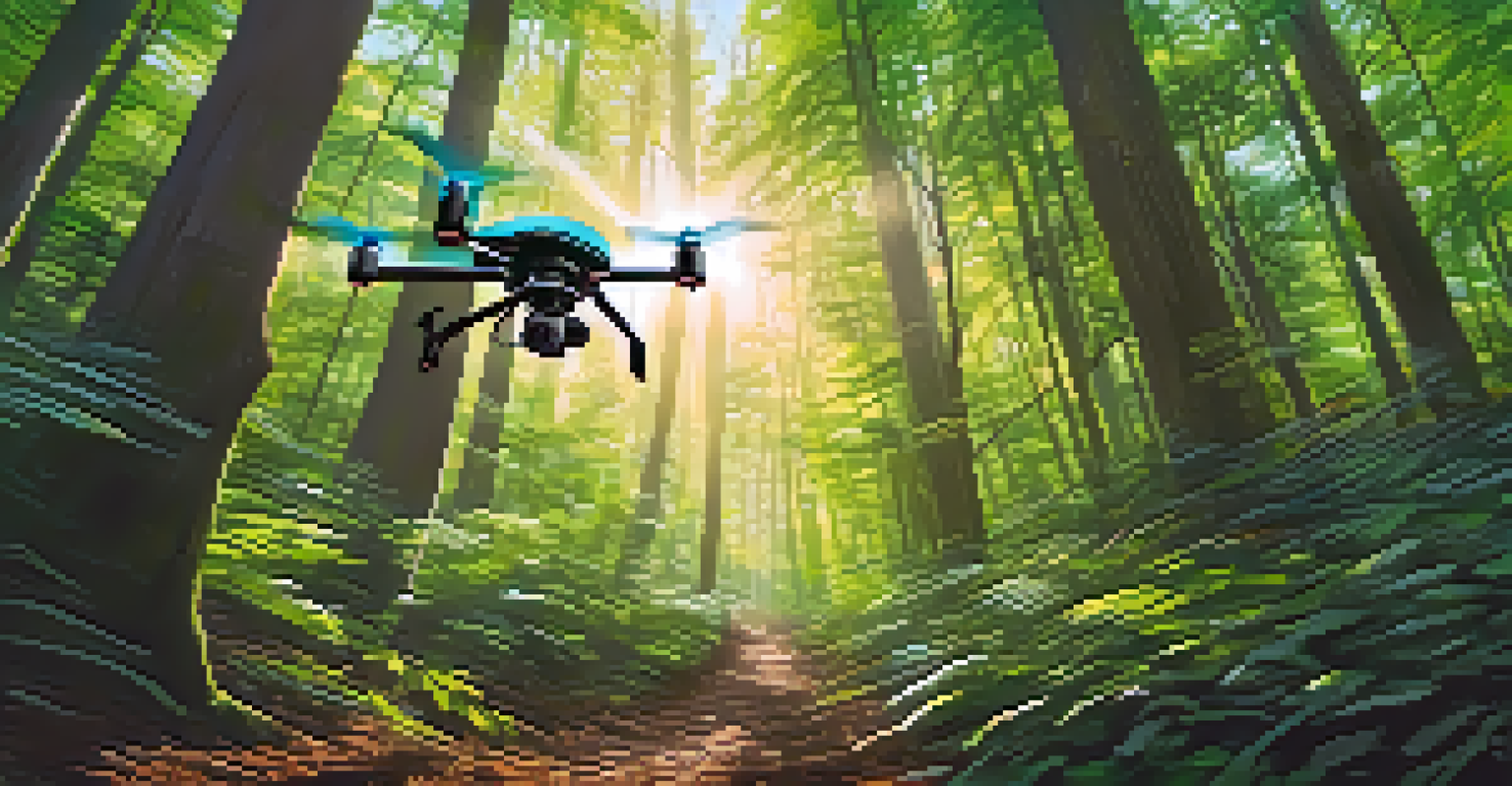Drones in Filmmaking: Aerial Perspectives and New Techniques

The Rise of Drones in Modern Filmmaking
In recent years, drones have revolutionized the way filmmakers capture stunning visuals. Once dominated by helicopters and cranes, aerial shots are now accessible and affordable, allowing filmmakers of all sizes to elevate their storytelling. This shift not only enhances cinematic quality but also democratizes the art of filmmaking.
The best part about filmmaking is that it allows you to tell stories from different perspectives, and drones offer a new way to do just that.
Drones offer versatile options that can be adapted to various shooting conditions. They can fly low to capture intimate scenes or soar high for breathtaking landscapes, delivering perspectives that were previously hard to achieve. This flexibility has empowered directors to think outside the box and push creative boundaries.
Moreover, the advent of drone technology has led to new filming techniques, such as tracking shots and dynamic movements that add depth to storytelling. Filmmakers can craft more engaging narratives by using these aerial perspectives to draw viewers into the action, making the experience more immersive.
Understanding Drone Technology for Filmmakers
Before diving into drone filmmaking, it's crucial to understand the technology behind these flying cameras. Drones are equipped with stabilization systems and high-resolution cameras that ensure smooth footage, even in windy conditions. Familiarity with these features can enhance the quality of your shots significantly.

Different drones come with various specifications tailored for specific filming needs. For instance, some models are designed for lightweight portability, while others offer robust capabilities for professional use. Knowing which drone suits your project can save time and elevate your production value.
Drones Redefine Filmmaking Aesthetics
Drones have made aerial shots more accessible, enhancing storytelling and visual quality for filmmakers of all sizes.
Additionally, filmmakers should be aware of the importance of battery life and flight time. A well-planned shoot takes into account the drone's operational limits, ensuring you capture all necessary scenes without interruptions. Understanding these technical aspects can lead to a more seamless filming process.
Legal Considerations for Drone Filming
Filmmakers must navigate a complex landscape of regulations when using drones. In many countries, drone operators are required to obtain licenses and adhere to specific guidelines to ensure safety and privacy. Familiarizing yourself with these regulations can prevent legal issues down the line.
Drones have democratized filmmaking, giving everyone the chance to create stunning visuals without the need for a big budget.
In the U.S., for instance, the Federal Aviation Administration (FAA) mandates that drone pilots register their devices and follow operational rules. These rules include maintaining a certain distance from people and structures, as well as flying below a specific altitude. Compliance not only ensures safety but also protects your filmmaking project.
Moreover, securing permissions for filming in public or private spaces is essential. Respecting the rights of individuals and property owners fosters goodwill and can enhance your reputation as a responsible filmmaker. Being proactive about these legalities will save you headaches and allow you to focus on your creative vision.
Creative Techniques Using Drones
Drones open up a world of creative possibilities for filmmakers. One popular technique is the 'drone reveal,' where the camera ascends to unveil a vast landscape. This technique can create dramatic tension and surprise, effectively drawing viewers into the narrative.
Another innovative approach is using drones for dynamic tracking shots. By following a subject from above, filmmakers can craft exhilarating chase scenes or capture the flow of events in a way that traditional cameras cannot. This adds a layer of excitement and engagement, keeping audiences on the edge of their seats.
Legal Knowledge is Essential
Filmmakers must navigate complex regulations regarding drone usage to ensure compliance and safeguard their projects.
Additionally, filmmakers can experiment with different flight patterns, such as orbits or zig-zag movements, to create unique visual effects. These creative techniques not only enhance storytelling but also allow filmmakers to showcase their signature style, setting their work apart in a crowded market.
The Impact of Drones on Documentary Filmmaking
Drones have become invaluable tools in documentary filmmaking, providing access to remote locations that may be difficult to reach otherwise. For example, filming wildlife in their natural habitats can be achieved with minimal disturbance, allowing for authentic storytelling. This capability enhances the documentary's emotional impact and connection with viewers.
Moreover, drones can capture sweeping vistas that provide context and setting, enriching the narrative. By showcasing the environment, filmmakers can better illustrate the challenges faced by their subjects, adding depth and resonance to the story. This approach fosters a more profound understanding of the issues at hand.
The ability to tell compelling stories from unique angles has transformed the landscape of documentary filmmaking. Drones allow filmmakers to highlight both the beauty and the struggles of our world, making their messages more poignant and relatable. This shift has led to a new era of impactful storytelling.
The Future of Drones in Filmmaking
As technology continues to evolve, the future of drones in filmmaking looks promising. Innovations such as AI-powered drones are on the horizon, enabling automated filming processes that streamline production. This could free filmmakers to focus more on creativity rather than technical execution.
Moreover, advancements in battery technology and flight capabilities will likely extend drone usage, allowing for more extended shoots and complex aerial maneuvers. This means filmmakers can capture even more breathtaking visuals, pushing the limits of what’s possible in storytelling.
Innovative Techniques Expand Creativity
Drones enable filmmakers to explore unique filming techniques, enriching narratives and engaging viewers in new ways.
Additionally, as drones become more integrated into various aspects of filmmaking, we can expect to see new genres and styles emerge. Filmmakers will continue to experiment with these tools, leading to fresh narratives and innovative techniques that challenge traditional filmmaking conventions.
Conclusion: Embracing Aerial Storytelling
In conclusion, drones have undeniably transformed the landscape of filmmaking, offering new perspectives and techniques that enhance storytelling. As filmmakers embrace these tools, they unlock the potential to craft more engaging narratives that resonate with audiences. The integration of aerial shots not only elevates visual quality but also enriches the overall viewing experience.
By understanding the technology, legal considerations, and creative techniques, filmmakers can harness the power of drones effectively. As they continue to explore this medium, the possibilities for innovative storytelling will only expand, paving the way for exciting new projects.

Ultimately, the journey of filmmaking is all about storytelling, and drones provide a fresh lens through which to share our narratives. By embracing aerial perspectives, filmmakers can connect with audiences in deeper and more meaningful ways, transforming how we experience stories.